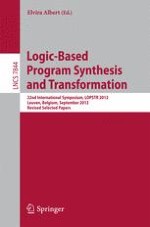This book constitutes the thoroughly refereed post-conference proceedings of the 22nd International Symposium on Logic-Based Program Synthesis and Transformation, LOPSTR 2012, held in Leuven, Belgium in September 2012.
The 13 revised full papers presented together with 2 invited talks were carefully reviewed and selected from 27 submissions. Among the topics covered are specification, synthesis, verification, analysis, optimization, specialization, security, certification, applications and tools, program/model manipulation, and transformation techniques for any programming language paradigm.
